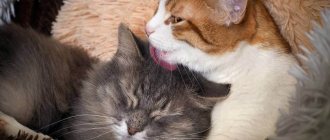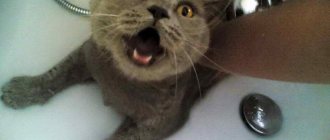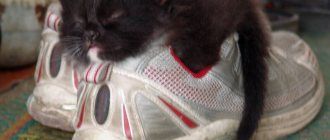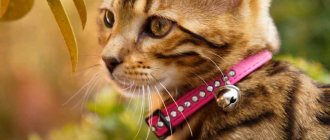How experts explain cats' love for boxes and rustling things
If outdoor cats always have grass, bushes and trees to hide, then indoors they are limited in movement. A box house for a cat is also an excellent hiding place where no one can see it. The reaction to a box or package is dictated by wild cat instincts. If something rustles or has a certain smell, it means it is prey or game.
Experts say cats have a natural craving for shelter. Fearful and anxious cats feel the need to hide away from prying eyes. The box represents a safe, enclosed space for them. Active and inquisitive pets, on the contrary, want to explore everything around them, play with bags or climb into various boxes.
The rustling package causes a storm of emotions in them: it moves like a mouse in a hole, rolls around, sticks to the fur and looks like an attacking enemy. However, it does not cause pain. Cats are ready to “fight” with such a toy, freely using their claws and teeth. The hanging package is no less interesting: you can climb inside and use it as a hammock.
If a cat climbs into a bag or box, then it is trying to attract the owner’s attention and play with him. Or she just wants to relax and chooses a secluded place to sleep.
Why do cats love boxes so much?
Cats love cardboard boxes - size and color don't matter! Our cats may prefer this simple and very inexpensive accessory to the most expensive and advanced toys. For a normal psychophysical state, it is vital for them to settle down in confined spaces, and banal penny cardboards are the most convenient option for this.
Cats choose cardboards - and do the right thing!
Why is this so? There are many versions, but there is no clear answer. But don’t let this stop you from giving your pet another box in which he will feel:
- comfortable and warm;
- interesting and fun;
- calm and reliable;
- cozy, like in childhood.
A box is the best gift for your cat
In an ordinary cardboard box, oddly enough, cats feel safer and more comfortable than anywhere else. Here, in their opinion, they are guaranteed to be protected.
What I think about is how beautiful I am
A love of boxes is a trait of all cats.
An inexplicable love for boxes is inherent in all cats, not just our pets. Many zoos and safari parks are now actively offering the boxes they adore to large predators.
Photo gallery: packaging for a big cat
A lion cub is the same as a kitten; it is safe and secure for him to sleep in a box.
Even the formidable jaguar wants to feel small
The tiger demanded a larger box - can you really refuse him?
For the lynx, the box became both a crib and an observation post
The leopard slightly expanded the box to fit its dimensions
Cheetah with cubs - it’s convenient to raise children in a box
The caracal chose a box to match the color of its skin - what a great disguise!
Video: reasons for cats' love of boxes
The box is an ideal place for an ambush
Nothing can be done against nature - our charming domestic, completely tame cats, by nature, were and remain passionate hunters. In natural habitats, many feline predators can hide in shelters for a long time, waiting for prey, and then, choosing an opportune moment, quickly attack from an ambush.
A cardboard box is the best springboard for an attack
Cats do not necessarily hunt to satisfy their hunger. Cats walking on their own—that is, cats that are walking on their own and are well-fed—often bring birds, lizards, mice, and even rats they have killed as gifts to their owners. Look, they say, I caught this myself, played with it a little and brought it to you - help yourself, dear!
But a lazy apartment cat, who has neither enemies nor prey, can easily put on a show in which the terrible enemy will be a towel falling on the floor, and the prey, for example, will be the owner’s legs... And our hero will picturesquely begin to jump out of the box, take incredible poses and fearlessly rush to attack! However, you have probably observed all this yourself, and more than once.
In a protected box
Pleasant childhood memories of cats - about an affectionate mother, tasty milk, funny games with brothers and sisters - are most often associated with the cardboard box where the “birthing center” was set up. That is, the box seems to them to be an ideal shelter in order to escape from various stressful situations.
For kittens, a box is a home
The nature of an adult cat is such that, unlike a dog, it prefers not to solve problems that have arisen, but to get away from them. In this sense, a magic cardboard box is an ideal shelter, because it helps not only to hide from reality, but to briefly return to a happy, problem-free childhood, where all difficulties were solved as if on their own.
Such behavioral strategies were studied by Claudia Vincke, a veterinary scientist from Holland. Ethological studies were carried out in several cat shelters and concerned the rapid social adaptation of animals in trouble. So, cats that had the opportunity to hide in boxes came out of stress much easier and more calmly accepted new living conditions and new owners.
No matter how hard cats try to seem proud and self-sufficient, they really miss their owners. When you leave home for the whole day to go to work, in your haste you often forget to even pet your pet goodbye. And he will become sad all the time while you are gone.
Master, I miss you - come back to whom you told!
How does a pet spend its leisure time when left alone at home? Some people will simply fall asleep, while others will cause chaos in their apartment out of boredom. But both of them would absolutely love a cardboard box for sleeping and playing - preferably not a brand new one, but one in which the beloved owner kept his things for at least a short time.
Video: cat hide and seek
Box - heat generator
Cats are very thermophilic. And this is by no means a whim of a pampered animal - the temperature comfort zone for a cat is in the range from 30 to 36 degrees, which is much higher than the usual human norm. That’s why pets so often cling to their owner, his warm hands, and love to crawl under the blanket with him.
Who is where - and I’m in the house, it’s warm here
There is a version according to which the most ancient ancestors of modern domestic cats lived in hot desert areas. That is why their current descendants still love to bask in the sun, do not tolerate cold well and, by the way, consume very little water - unless, of course, they eat dry food.
Due to the peculiarities of its structure, corrugated cardboard acts as a thermos and retains the cat’s body heat well. Hence the funny predilection for cramped, obviously oversized cardboard boxes - they simply have less heat loss. This same property of cardboard boxes also explains how elderly animals with sore joints like to climb into them: they set up a “physiotherapy room” here with warming up their paws.
Boxes help keep cats much-needed warmth
Video: why cats hide
Can these habits be dangerous for your pet?
Unfortunately, a bag is not always a safe toy. It is not uncommon for a cat to lick, chew, or even eat a rustling plastic bag. Scientists suggest that there may be the following reasons for this:
- poor nutrition;
- problems with the oral cavity and/or digestion;
- early separation of the kitten from the cat;
- stress;
- I like the taste of fats and gelatin in polyethylene;
- attractive smooth texture;
- the smell of something tasty that was previously in the bag.
The habit of chewing bags can be dangerous for your pet. If he chews on a plastic bag and accidentally swallows a piece, this can lead to suffocation or intestinal obstruction. Therefore, it is important not to throw bags anywhere and not allow your cat to get them out of the trash can.
Other sensations
It is also noted that the sound from the bag may remind pets of the noise emanating from rodents when they run through fields or other objects. They understand this: rustling means prey. They can be attracted by various acoustic signals. So don’t be surprised by this behavior of your pet.
Moreover, according to scientific point of view, your pet is a mammal of the cat family of carnivores. So what you are observing is their natural behavior. Cats are small predators, and you shouldn't teach them something like that.
What to do if the cat ate the bag?
If suddenly the cat swallows cellophane, wait a little, do not give an antiemetic or laxative. In the absence of symptoms of suffocation, the animal will try to induce vomiting on its own. If this does not happen or the cellophane is sticking out of the mouth, do not try to pull it out yourself - it is better to immediately take your pet to the veterinarian. If the cat is interested in a plastic or plastic bag, you need to distract its attention with other safe objects: a laser pointer, a ball, a feather wand, or just a treat.
Conclusion
Cats' actions may always remain a mystery to us, but this is part of their charm. Of course, if any of the above actions seem repetitive or out of control, you may want to contact your veterinarian.
Remember: eating non-food products (bags or other garbage) can lead to intestinal blockage, and therefore you should not neglect this phenomenon. But often the explanations for the behavior of four-legged creatures are quite simple: the box and package can attract smells, acoustic signals or the heat emanating from them.
Found a violation? Report content
Pros and cons of this behavior
The main positive aspect of the fact that cats adore boxes is the availability of the latter. Owners do not have to spend money on expensive houses; it is quite enough to take a suitable container and make a hole for them.
I recommend: Why cats play and how to do it correctly with them
Note! The box can be replaced with a bag, basin, basket - the item that your pet will perceive as home.
Scientific research
This question has interested even the scientific minds of our world for a very long time, and there are a huge number of versions on this subject. The famous Dutch veterinarian Claudia Vinck has been studying the behavior of cats in shelters for a long time. The decisive experiment in her work was the experiment with newly arrived animals that were still in a state of stress. Wink seated them in two different rooms, one of which was equipped with various hiding places, and the other remained free for prying eyes. As a result, animals with the opportunity to be left alone with themselves adapted to new living conditions much faster.
The result of the study was confirmation of the opinion that it is easier for cats to run away and hide from problems than to solve them, regardless of their size and habitat.











